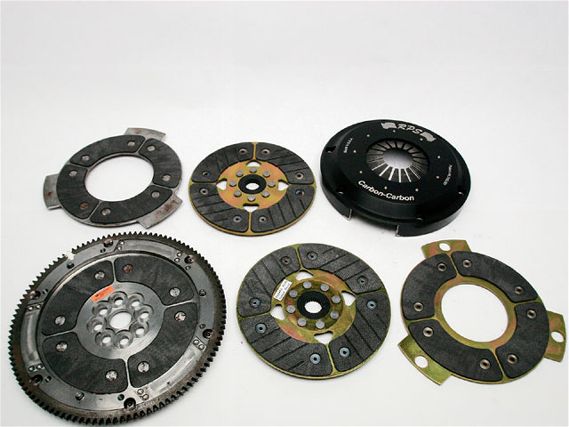 | One Down, Who Knows How Many To Go? - Our Garage - RPS Billet Carbon Twin Disc Clutch
| One Down, Who Knows How Many To Go? - Our Garage - RPS Billet Carbon Twin Disc Clutch
With Yamz's car finished and plastered on last month's cover, we can devote our attention to the rest of our cars that need a lot more work. Nads', for one, since he managed to thrash his factory transmission and rev his motor to the brink of extinction (The new redline was set at 9,000, was it not? - JN). Then there's Ro's car, which may or may not ever be finished depending on whether or not he can find any more space in his apartment to store parts. Elliott's car needs the most work just to get it to look like a regular car again. The rest of us are just sitting by trying to produce this magazine each month.
RPS Billet Carbon Twin Disc ClutchThere comes a time in life where you just have to say screw it and spring for the best that's out there. We know how tough it is to do. But there's a reason why this DA has taken 5 years to build. And no, it's not to Walk the Earth. Each part purchased is a calculated decision, just like all the mail order brides Chimpy has browsed for on the web (I've been searching for seven years, and still haven't found the right one. - AA). Fact of the matter is, Chimpy's straight LS engine is built to handle 500-600 hp without breaking a sweat. Traction became our main problem, so we exorcised that demon by installing a Quaife ATB differential along with a pair of Drive Shaft Shop (DSS) Level 3 axles. Everything was all Kool and the Gang, until we realized that all that power and traction would mean nothing if we couldn't transfer it from the engine to the gearbox. Now, there are tons of clutch combinations on the market, but Chimpy wanted the best. Reliability was his main concern, which prompted him to make a list of all the 500+ hp production cars on the road. Most don't use conventional clutches. Supercars like the Porsche Carrera GT and the Lamborghini Murcielago all use multi-disc clutches to put the power down reliably, all while minimizing shock to the drivetrain. Single disc clutches are great, but we've experienced only short-term luck with them on higher hp setups. But Chimpy's never driven or had any first-hand experience with a multi-disc setup, so like most of you he relied on first-hand accounts from current users-until now.
Rob Smith is the guy that helped propel Junior Asper into the 13s and into the 12s. If you don't know who Junior Asper is, you'll have to wait for the history lesson in a later issue. Rob was the go-to guy back in the '90s for the Honda cognoscenti in Southern California (and NY). If you wanted to go fast, he's the guy you looked up. Christian Rado wanted to get to the next level in his DC2, and worked for Rob back in the mid-nineties to get his car up to strictly racecar spec. Racecar spec is what you need if you're making 400+ hp. Racecar spec is what you get if you choose RPS's Billet-Carbon clutch. There's a reason why it costs as much as the DA it's going on. The engineering behind it needs a separate story to explain it fully, but basically, the carbon used in the discs and plates is the same exact compound used in Formula 1. To clear the controversy up, carbon is better than Kevlar at withstanding heat. When a clutch heats up, resins and impurities rise to the surface and cause what's commonly known as glazing. Carbon has no resins. The hotter carbon gets, the stickier it gets, which helps to hold torque pass after pass on the strip. If Kevlar gets hot enough, it will glaze over. The RPS carbon components sit in a kiln for thousands of hours at a heat normally reserved for hell and length of time appropriate for inmates at Alcatraz. You can imagine the costs associated with keeping that kiln burning for several months straight. Make no mistake about it: this is the Ferrari of clutches, and since Chimpy seems to think his DA will be making Ferrari-type power, why not spring for the best?
